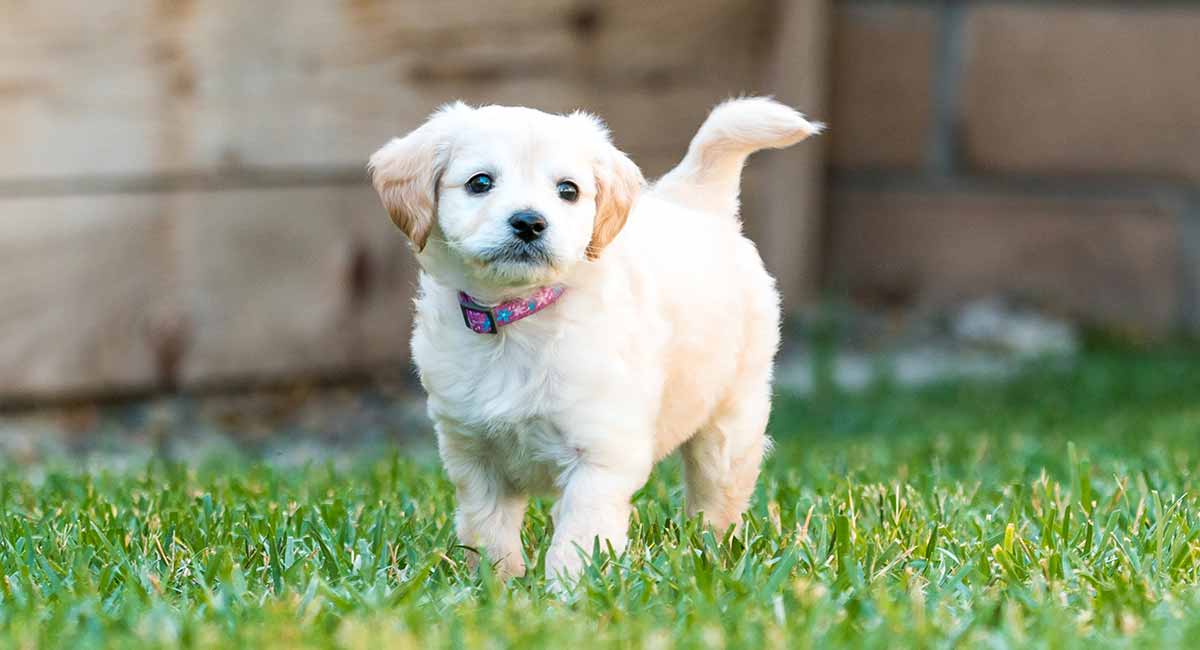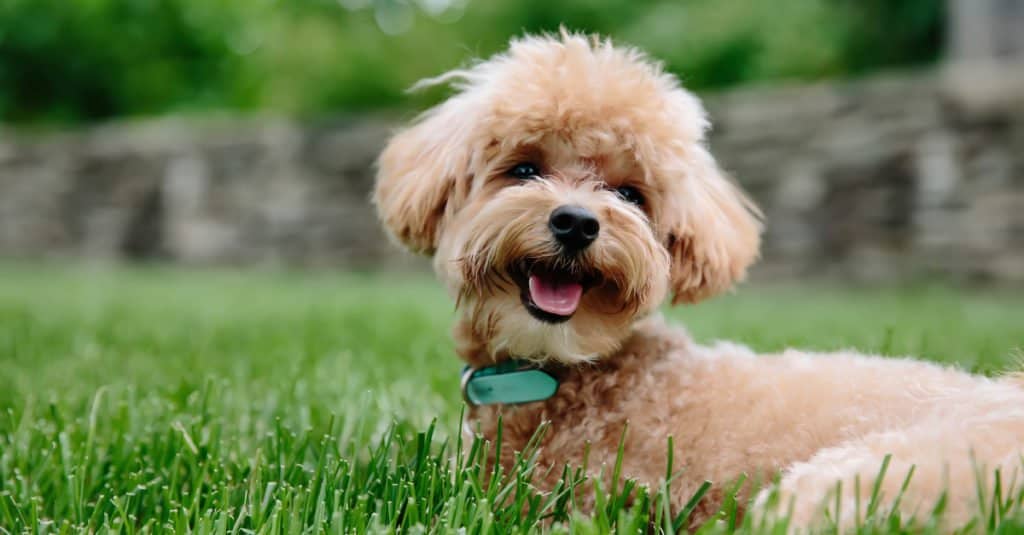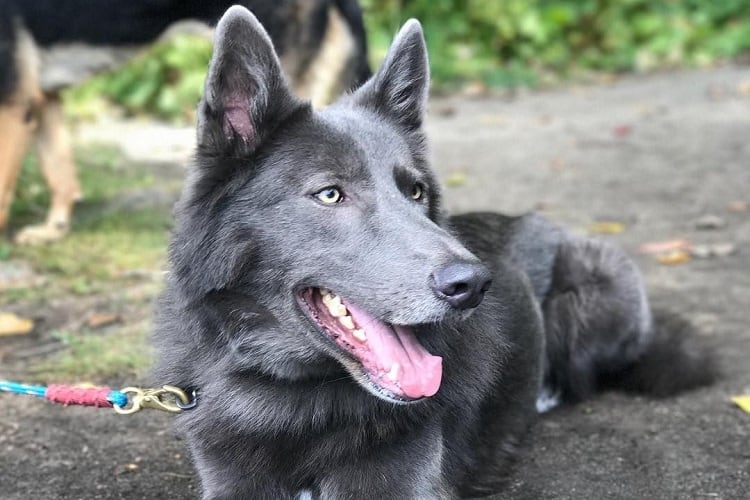A Mini Labradoodle is a crossbreed dog resulting from the breeding of a Labrador Retriever and a Miniature Poodle.. This hybrid breed is known for its small size, adorable appearance, and friendly nature.

Beyond their physical attributes, Mini Labradoodles are known for their friendly and outgoing personalities. They are playful and energetic, making them great companions for individuals or families with an active lifestyle. Their intelligence and trainability also make them highly adaptable and responsive to obedience training. Mini Labradoodles are known to be affectionate and get along well with families, forming strong bonds with both adults and children.
While there are many advantages to owning a Mini Labradoodle, there are also some considerations to keep in mind. It's essential to understand the exercise and grooming needs of this breed as well as any potential health concerns. Proper training and socialization are crucial to ensuring a well-behaved and balanced Mini Labradoodle. Finally, common questions about Mini Labradoodles include their hypoallergenic properties, shedding tendencies, and average lifespan.
What is a Mini Labradoodle?
Let's dive into what makes them so special! Unravel the intriguing aspects of their breeding, as well as their unique size and appearance.
Breeding
Breeding Mini Labradoodles involves a careful selection and pairing process of Labrador Retrievers with Miniature Poodles. The ultimate goal is to create a doodle that is smaller in size, while inheriting the desirable traits from both parent breeds. This intentional breeding is aimed at promoting specific characteristics such as hypoallergenic coats, a friendly temperament, and intelligence.
During the breeding process of Mini Labradoodles, breeders focus on producing puppies that possess a balanced combination of traits from each parent breed. Factors like size, coat type, and temperament are taken into consideration to ensure that the resulting puppies meet the desired standards. Responsible breeders also conduct health tests on the parent dogs to minimize the risk of inherited genetic diseases. Furthermore, they consider the compatibility and genetic diversity of the parents to enhance the overall health of the offspring.
It is important to understand that not all Mini Labradoodles will exhibit the exact same traits, as each individual puppy can be unique. Some may have stronger Labrador-like characteristics, while others may favor the Poodle side more. This diversity is a result of the intricate genetic inheritance from the parent breeds.
When searching for a Mini Labradoodle, it is crucial to select a reputable breeder who places a high priority on the health and well-being of their dogs. A responsible breeder should provide necessary documentation and offer continuous support and guidance throughout the process of adopting a Mini Labradoodle.

Giving due consideration to responsible breeding practices is of utmost importance to ensure the well-being and quality of Mini Labradoodles. By choosing the right breeder, potential owners can find a healthy and well-suited companion for their family.
Size and Appearance of a Full Grown Mini Labradoodle
Size and Appearance | Height | Weight |
Miniature | 14 to 16 inches | 15 to 25 pounds |
Medium | 17 to 20 inches | 30 to 45 pounds |
When it comes to understanding the size and appearance of Mini Labradoodles, it's helpful to refer to the table above. This table clearly outlines the different sizes of full grown Mini labradoodles, as well as their corresponding heights and weights.
Mini Labradoodles are available in two sizes: miniature and medium. The miniature size falls within the range of 14 to 16 inches in height and weighs between 15 to 25 pounds. On the other hand, medium-sized Mini Labradoodles measure around 17 to 20 inches tall and weigh approximately 30 to 45 pounds.
In terms of appearance, Mini Labradoodles tend to inherit physical characteristics from both Labrador Retrievers and Poodles. They typically have a sturdy body with a well-proportioned build. The texture of their coats can vary, with some having wavy coats while others have curly coats. This variation is influenced by the genetics of each parent breed. Additionally, Mini Labradoodles come in a wide range of coat colors, including black, chocolate, cream, apricot, and even multi-color combinations.
Temperament and Personality Traits of Mini Labradoodles
Curious about the temperament and personality traits of mini Labradoodles? Get ready to discover their playful and energetic nature, their intelligence and trainability, as well as their affectionate demeanor and compatibility with families.
Playful and Energetic
When it comes to Mini Labradoodles, their playful and energetic nature is one of their standout traits. Here are some key points to consider:
Active companions: Mini Labradoodles love to play and have plenty of energy to burn. They enjoy engaging in games and activities that require physical exertion.
Exercise needs: Due to their playful and energetic nature, Mini Labradoodles require regular exercise to keep them happy and healthy. They thrive with daily walks, interactive play sessions, and opportunities to run and explore.
Mental stimulation: In addition to physical exercise, this breed benefits from mental stimulation to channel their energy in a constructive manner. Puzzle toys, obedience training, and agility exercises can help keep them mentally sharp.
Interaction with humans: Mini Labradoodles are highly social and enjoy interacting with their human families. They love to participate in family activities and are known for their affectionate and friendly nature.
Interaction with other dogs: Being playful and energetic, Mini Labradoodles often get along well with other dogs. Proper socialization from an early age can further enhance their ability to get along with other canine companions.
The Mini Labradoodle breed originated in the late 20th century, when breeders sought to create a smaller version of the Labradoodle by combining the intelligence and trainability of the Miniature Poodle with the friendly and outgoing nature of the Labrador Retriever. By carefully selecting parent dogs and focusing on desired temperament traits, they successfully cultivated a breed that embodies the playful and energetic nature that Mini Labradoodles are known for today.
Intelligent and Trainable

The Mini Labradoodle breed is renowned for its intelligence and trainability. Here are some key characteristics that distinguish them:
- Quick Learners: Mini Labradoodles are highly intelligent dogs and adept at quickly grasping new commands and tricks. They possess a natural aptitude for learning and derive pleasure from the mental stimulation that accompanies training.
- Problem-Solvers: Owing to their intelligence, Mini Labradoodles excel at problem-solving. They possess the ability to analyze situations and devise innovative solutions, making them well-suited for tasks such as search and rescue or assistance work.
- Adaptability: Mini Labradoodles are highly adaptable. They can effortlessly adapt to various environments and lifestyles, making them suitable for owners with diverse living arrangements. Whether in a cozy apartment or a spacious home, they thrive with the right mix of mental and physical stimulation.
- Eager to Please: Mini Labradoodles possess a strong desire to please their owners, rendering them highly receptive to training. They find motivation in praise and rewards, and their enthusiasm for learning and satisfying their owners ensures a smooth and enjoyable training process.
In the late 20th century, the breeding of Labradoodles gained popularity due to their hypoallergenic coat and the desirable traits inherited from both Labrador Retrievers and Poodles. Specifically, the Mini Labradoodle variation was developed with the aim of creating a smaller, more compact version of the Labradoodle. Breeders sought to combine the intelligence and trainability of Poodles with the friendly and outgoing nature of Labradors. Through meticulous selection and breeding, Mini Labradoodles were developed to become exceptional family pets and companions. Today, their intelligence, trainability, and affectionate personalities continue to make them highly sought after.
Affectionate and Good with Families
Mini Labradoodles are known for their affectionate nature and their ability to bond well with families. Here are some reasons why they are considered to be good with families:
- 1. Playful and loving: Mini Labradoodles have a playful and energetic personality. They love to engage in fun activities with their family members, making them great companions for both children and adults.
- 2. Patient and gentle: Mini Labradoodles have a gentle and patient temperament, which makes them well-suited for families with young children. They are known to be tolerant and can handle the excitement and energy of kids.
- 3. Social and friendly: Mini Labradoodles are naturally social dogs and enjoy being around people. They are friendly, welcoming, and often get along well with strangers and other pets, making them a great addition to any family.
- 4. Protective and loyal: Mini Labradoodles have a strong sense of loyalty towards their family members. They can be protective of their loved ones and are known to be alert and responsive, making them excellent watch dogs.
Mini Labradoodles: Pros and Cons
When considering getting a Mini Labradoodle, it's important to weigh the pros and cons to determine if this breed is the right fit for your lifestyle.
- Pros:
- Playful and Energetic: Mini Labradoodles are known for their playful and energetic nature, making them great companions for active individuals or families.
- Intelligent and Trainable: These dogs are highly intelligent and eager to please, making them easy to train and teach new commands.
- Affectionate and Good with Families: Mini Labradoodles are generally very affectionate and form strong bonds with their owners, often making them great family pets.
- Cons:
- High Exercise Needs: Due to their high energy levels, Mini Labradoodles require regular exercise and mental stimulation to prevent behavior problems.
- Grooming Requirements: Their curly or wavy coat requires regular grooming to prevent matting, including brushing and occasional professional grooming.
- Potential Health Issues: As with any breed, Mini Labradoodles may be prone to certain health issues, including hip dysplasia, eye problems, and allergies.
Fact: Mini Labradoodles are a popular choice for people with allergies due to their low shedding coat. It's important to note that no dog breed is completely hypoallergenic and individual reactions may vary.
Caring for a Mini Labradoodle
Caring for a Mini Labradoodle means tending to their exercise, grooming, and health needs. Discover how to keep these adorable pups active and fulfilled, while also understanding the grooming essentials to maintain their unique coat.
Exercise and Activity Needs
When it comes to exercise and activity needs, it is important to understand that Mini Labradoodles are energetic and require regular physical activity to stay healthy and happy.
- Daily Exercise: Mini Labradoodles should engage in at least 30 minutes to an hour of exercise every day. This can include brisk walks, playtime in a fenced yard, or interactive games such as fetch or hide-and-seek.
- Mental Stimulation: In addition to physical exercise, Mini Labradoodles also need mental stimulation to prevent boredom. Puzzle toys, obedience training sessions, and interactive play can help keep their minds active.
- Off-Leash Activities: Mini Labradoodles enjoy opportunities to run and play off-leash in safe environments. Visits to a dog park or open areas where they can roam freely and socialize with other dogs can be beneficial.
- Water Activities: Some Mini Labradoodles enjoy swimming and water-related activities. If your dog enjoys being in the water, consider taking them to a dog-friendly beach or providing a small pool or sprinkler for them to cool off and have fun.
- Adjust for Age and Health: The exercise and activity needs of Mini Labradoodles may vary depending on their age and overall health. Younger dogs may have more energy and require more vigorous activities, while older dogs may need gentler exercises. It is important to consult with a veterinarian to determine the appropriate level of exercise for your Mini Labradoodle.
By providing regular exercise and engaging activities, you can ensure that your Mini Labradoodle remains physically and mentally stimulated, leading to a happy and well-rounded companion.
Grooming Requirements
When it comes to the grooming requirements of Mini Labradoodles, there are a few key considerations to keep in mind:
- Coat maintenance: Mini Labradoodles have a dense, curly or wavy coat that requires regular brushing to prevent matting and tangling. Aim to brush their coat at least two to three times a week to keep it looking healthy and tangle-free.
- Bathing: While Mini Labradoodles do not need frequent bathing, they should be bathed when they are visibly dirty or have a strong odor. Use a gentle dog shampoo and thoroughly rinse their coat to remove any residue.
- Trimming: Mini Labradoodles may require occasional trimming to maintain the desired length and shape of their coat. This can be done by a professional groomer or with proper training and grooming tools.
- Ear care: Like many dogs, Mini Labradoodles are prone to ear infections. Regularly check their ears for redness, odor, or discharge, and clean them with a vet-approved ear cleaner if necessary.
- Nail trimming: Keep an eye on your Mini Labradoodle's nails and trim them regularly to prevent overgrowth. If you hear them clicking on the floor, it's a sign that they are due for a trim.
Pro-tip: Establish a grooming routine early on to help your Mini Labradoodle become comfortable with the grooming requirements. Reward them with treats and praise during grooming sessions to create positive associations.
Health and Medical Considerations

When considering a Mini Labradoodle as a pet, it's important to understand the health and medical considerations associated with this breed. Here are some key factors to keep in mind:
1. Genetic Health: Like any other breed, Mini Labradoodles can be prone to certain genetic health conditions. These may include hip dysplasia, eye issues such as progressive retinal atrophy, and certain skin problems. It is crucial to choose a reputable breeder who conducts health screenings on their breeding dogs to reduce the risk of these conditions.
2. Regular Vet Check-ups: Mini Labradoodles, just like any other dog, require regular veterinary check-ups. These visits help ensure that your dog is in good overall health and allow for any potential issues to be detected early on.
3. Vaccinations and Preventative Care: To maintain your Mini Labradoodle's health, they will need to receive regular vaccinations as recommended by your veterinarian. They should be kept on a regular schedule for flea, tick, and heartworm prevention.
4. Exercise and Weight Management: Regular exercise is important for the overall well-being of your Mini Labradoodle. Engaging in daily physical activities helps to maintain a healthy weight, promote good cardiovascular health, and prevent obesity-related issues.
5. Dental Care: Dental hygiene is essential for your Mini Labradoodle's overall health. Regular brushing of their teeth and the use of dental chews can prevent dental diseases and maintain good oral hygiene.
Remember, while Mini Labradoodles are generally healthy dogs, it is important to be proactive in their healthcare. By providing proper veterinary care, a balanced diet, regular exercise, and maintaining good oral hygiene, you can ensure the well-being of your Mini Labradoodle.
Socialization of Mini Labradoodles
Mini Labradoodles are social and friendly dogs that enjoy interacting with both people and other dogs. Socializing with people and other dogs is an important aspect of their development and helps them become well-rounded and well-behaved pets.
When it comes to socializing with people, Mini Labradoodles are naturally friendly and enjoy being around their family members. They are known for their affectionate nature and will often seek out attention and affection from their owners. It is important to expose them to a variety of different people, including strangers, to help them become comfortable and friendly in various social settings.
In terms of socializing with other dogs, Mini Labradoodles are generally good at getting along with their canine counterparts. Like all dogs, proper introductions and positive experiences are key to ensuring a positive and well-behaved interaction. It is important to expose them to different dogs of different sizes, breeds, and temperaments to help them develop good social skills and manners.
By socializing Mini Labradoodles with both people and other dogs, you are helping them build confidence, learn appropriate behavior, and develop good social skills. This will contribute to their overall well-being and make them enjoyable companions in various social settings.
The Mini Labradoodle breed was developed in the late 20th century as a cross between a Labrador Retriever and a Miniature Poodle. The aim was to create a smaller version of the Labradoodle, which combines the intelligence and trainability of the Poodle with the friendly and outgoing nature of the Labrador Retriever. The Mini Labradoodle has gained popularity as a family pet due to its hypoallergenic coat and friendly temperament. It has become a sought-after breed for those seeking a smaller-sized dog with the qualities of both the Labrador Retriever and the Poodle.
Are Mini Labradoodles Hypoallergenic?
Mini Labradoodles are often touted as a hypoallergenic dog breed, but it is important to understand what that actually means. While no dog breed is entirely hypoallergenic, Mini Labradoodles are known to be low-shedding, which can help reduce allergic reactions in people who are sensitive to pet dander.
The main reason why Mini Labradoodles are considered hypoallergenic is because they have a curly or wavy coat that resembles that of a Poodle. This type of coat is less likely to shed and release allergens into the environment. It's important to note that individual reactions to allergens can vary, and some people may still experience allergies or sensitivities to Mini Labradoodles.
If you or a family member has allergies, it is recommended to spend time with a Mini Labradoodle before bringing one home to see how you react. Are Mini Labradoodles Hypoallergenic? Some individuals with allergies may find that they can tolerate being around Mini Labradoodles, while others may still experience symptoms.
Regular grooming and proper hygiene practices can also help minimize potential allergens. Brushing the coat frequently and bathing the dog regularly can help remove any loose hair and dander that may cause allergies.
While Mini Labradoodles are generally considered to be hypoallergenic due to their low-shedding coat, individual reactions to allergens can vary. Are Mini Labradoodles Hypoallergenic? It is important to spend time with a Mini Labradoodle to assess your own allergic sensitivity before deciding to bring one into your home.

How Much Do Mini Labradoodles Shed?
Mini Labradoodles are known for their low shedding coats, making them a popular choice for individuals with allergies or those who prefer a cleaner home environment. They have a unique coat that combines the characteristics of both the Labrador Retriever and the Poodle. When it comes to shedding, Mini Labradoodles shed very minimally, if at all. The amount of shedding in Mini Labradoodles can vary from dog to dog, as it depends on the specific genetic makeup of each individual. It is important to note that their coats are considered to be hypoallergenic, which means they are less likely to cause allergic reactions in people who are sensitive to pet dander.
While Mini Labradoodles are known for their low shedding coats, regular grooming is still necessary to keep their coats healthy and free from matting. Brushing their fur regularly and scheduling professional grooming sessions every few months will help to minimize any loose hairs and keep their coat in good condition.
In summary, Mini Labradoodles shed very little, if at all. Their hypoallergenic coats make them a great option for individuals with allergies or those who prefer a low-shedding pet. Regular grooming is still necessary to maintain their coat's health, but overall, they are a great choice for individuals looking for a low-shedding dog breed.
What is the Average Lifespan of a Mini Labradoodle?
The average lifespan of a Mini Labradoodle is around 12 to 16 years. These dogs are generally healthy and can live a long and fulfilling life with proper care and attention. Regular exercise, a balanced diet, and routine veterinary check-ups are essential for maintaining their overall health and well-being.
Mini Labradoodles are a crossbreed between a Labrador Retriever and a Miniature Poodle. This hybridization often results in a healthier breed with fewer genetic health issues compared to purebred dogs. They may still be prone to certain health conditions such as hip dysplasia, progressive retinal atrophy, and certain allergies.
To ensure the longevity of your Mini Labradoodle, it is important to provide them with a nutritious diet, regular exercise to keep them physically active, and mental stimulation through training and playtime. Regular grooming, including brushing their coat and cleaning their ears, is also necessary to maintain their overall hygiene.
By providing proper care and attention, you can increase the chances of your Mini Labradoodle living a long and healthy life. It is always advisable to consult a veterinarian for specific guidance on your dog's individual needs and any potential health concerns.
Some Facts About Mini Labradoodles:
- ✅ Mini Labradoodles are a crossbreed between the Labrador Retriever and the Miniature or Toy Poodle.
- ✅ They were specifically bred to be smaller than standard Labradoodles.
- ✅ Mini Labradoodles have a calm temperament, get along with other people and dogs, and are easy to train.
- ✅ They have a hypoallergenic coat, making them suitable for people with allergies.
- ✅ Miniature Labradoodles combine the loyalty and intelligence of the Labrador with the low-shedding coat of the Poodle.
Frequently Asked Questions
1. What is a mini Labradoodle?
A mini Labradoodle is a crossbreed between a Labrador Retriever and a miniature or toy Poodle. They are smaller in size compared to standard Labradoodles and have the same characteristics but in a more diminutive form.
2. What are the vital statistics of a mini Labradoodle?
Mini Labradoodles are typically 14-16 inches tall and weigh between 15-30 pounds when full grown. They have a lifespan of 10-18 years, depending on their genetics and overall health.
3. Does a mini Labradoodle have a non-shedding coat?
Yes, mini Labradoodles have a low-shedding coat. They usually inherit the low-shedding trait from their Poodle parent, making them a suitable choice for individuals with allergies.
4. What is the temperament of a mini Labradoodle?
Mini Labradoodles are known for their calm temperament and friendly nature. They get along well with other dogs and people, making them great companion dogs for families.
5. How intelligent are mini Labradoodles?
Mini Labradoodles are highly intelligent dogs. They are easy to train and can quickly learn commands. Their intelligence is a result of combining the intelligence of the Labrador Retriever and the Poodle.
6. Can a mini Labradoodle be used as a service dog?
Yes, mini Labradoodles can make excellent service dogs. They are intelligent, trainable, and have a willingness to deliver. Their non-shedding coat and friendly nature make them a popular choice for various service roles, such as assisting individuals with disabilities or working alongside police officers.






